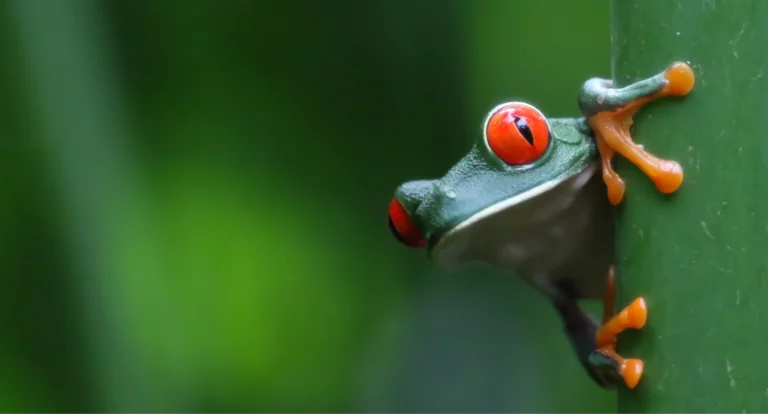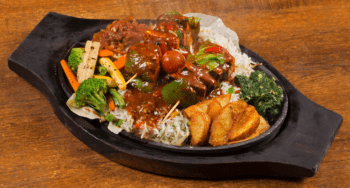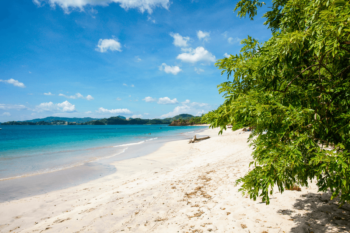Caño Negro Wildlife Refuge: What's Covered
Caño Negro Wildlife Refuge is a RAMSAR-designated international wetland in northern Costa Rica, 1 hour 45 minutes from La Fortuna near the Nicaraguan border. Day trip tours from La Fortuna ($50-80) include transportation, guided boat safari on Rio Frio River, and lunch, departing around 7:30am. Best wildlife viewing December-April when lower water levels concentrate animals; February-March peak for migratory birds joining resident species. Driving yourself to Los Chiles or Guatuso launch points gives flexibility to explore on your own schedule and combine with other northern Costa Rica attractions.
Quick Facts:
- Location & Access: Northern plains near Nicaraguan border; day trips from La Fortuna (1hr 45min drive), boat tours from Los Chiles or Guatuso
- RAMSAR Status: Internationally recognized wetland supporting local communities through “mixed refuge” eco-tourism model
- Best Season: December-April dry season when lagoon recedes concentrating wildlife; February-March for peak migratory bird viewing
- Tour Structure: 7:30am pick-up, scenic drive through volcanic landscapes, 2-3 hour boat safari, Costa Rican lunch included
- Wildlife Density: One of world’s most important wetlands with rare species including jabiru stork, three monkey species, wildcats
Caño Negro Wildlife Highlights:
- Bird Paradise – 300+ species including jabiru stork (tallest flying bird in Americas), herons, egrets, ibis, kingfishers, hawks, ospreys, toucans; February-March brings migratory populations
- Three Monkey Species – Howler monkeys (loud territorial calls), white-faced capuchins (tool users), elusive Geoffroy’s spider monkeys swinging through canopy
- Sloth Encounters – Both two-toed and three-toed sloths visible high in trees along riverbanks; similar slow-moving wildlife viewing as Monteverde
- Reptile Diversity – Caimans and crocodiles lurking in shallows, iguanas basking on branches, turtles sunbathing; resembles Tortuguero’s canal ecosystem
- Rare Mammal Sightings – Deer, river otters, tapirs visible; extremely lucky visitors spot jaguars, ocelots, or pumas (similar rare wildcats as Monteverde cloud forest)
Top Day Trip Experiences:
Tours from La Fortuna include 7:30am pick-up, 1hr 45min scenic drive through volcanic landscapes, 2-3 hour covered boat safari with bilingual naturalist guide, authentic Costa Rican lunch, and refreshments. Family-friendly gentle pace suitable for all ages—no strenuous hiking required unlike Arenal National Park trails. Guides carry telescopes for phone photography; bring telephoto lens and binoculars for optimal wildlife viewing. Overnight options at Natural Lodge Caño Negro or Hotel de Campo Caño Negro for dedicated birdwatchers wanting dawn/dusk activity.
Essential Packing: Sunscreen, hat, sunglasses (intense tropical sun on open water), lightweight long pants/sleeves (insect protection), strong mosquito repellent, camera with telephoto lens or smartphone, binoculars, comfortable clothing for boat sitting. Motion sickness rare due to slow-moving river pace.
Combine with La Fortuna Area: Most visitors pair Caño Negro day trip with Arenal hot springs (evening relaxation after morning wildlife viewing), La Fortuna Waterfall hike, Arenal Volcano National Park trails, hanging bridge tours, or zip-lining adventures. La Fortuna is 3 hours from both San Jose Airport (SJO) and Liberia Airport (LIR)—choose based on your complete Costa Rica itinerary.
Green Season Considerations: May-November still offers excellent resident wildlife viewing (monkeys, sloths, caimans, reptiles) though some migratory birds depart. Higher water levels create different ecosystem dynamics. Similar to visiting Arenal or Monteverde during rainy season—pack rain gear and embrace lush greenery.
Transportation Tips: Book shuttle services if not renting a car, or drive yourself to Los Chiles for more flexibility exploring northern zone. Los Chiles has better-maintained dock and established tour operators versus Guatuso. Consider renting a vehicle to combine Caño Negro with other northern attractions without coordinating multiple tour schedules.
If you need any help with a Costa Rica car rental, contact us now!
Caño Negro Wildlife Refuge packs more wildlife per square meter than almost anywhere else in Costa Rica – we’re talking 300+ bird species, caimans sunbathing on every riverbank, and three types of monkeys in a 25,000-acre wetland sanctuary. Located 90 minutes north of La Fortuna, this RAMSAR-designated wetland offers something the famous national parks don’t: guaranteed wildlife sightings without the crowds, especially during temporada seca (dry season, December-April) when animals concentrate around shrinking water sources. Boat tours from Los Chiles run $45-65 per person and take 2-3 hours, making this an easy day trip that gets you closer to wildlife than most walking trails ever could.
Key Takeaways
- Best Wildlife Density: Spot 300+ bird species, three monkey types, caimans, and perezosos (sloths) in one 3-hour boat tour
- Perfect Timing: Visit December-April when shrinking water sources concentrate wildlife for easier viewing
- Budget-Friendly: Tours cost $45-65 per person – half the price of similar experiences elsewhere
- Easy Access: 90-minute drive from La Fortuna with well-maintained roads (4×4 helpful but not required)
- Crowd-Free: Experience authentic wildlife viewing without fighting for photo spots
- Unique Ecosystem: Explore Costa Rica’s most important wetland, recognized internationally as a RAMSAR site
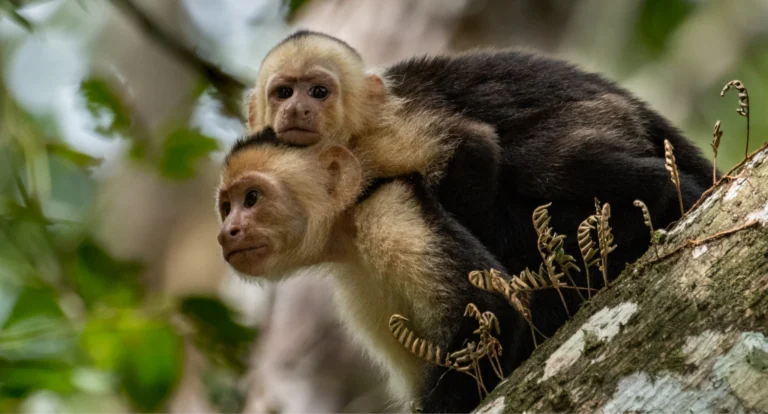
What Makes Caño Negro Different from Other Costa Rican Parks?
Think of Caño Negro as Costa Rica’s version of the Everglades – except with monos congo (howler monkeys) instead of alligators (though there are plenty of caimans too). This humedal (wetland) ecosystem creates perfect conditions for wildlife viewing that you won’t find in the cloud forests of Monteverde or the beaches of Manuel Antonio.
The refuge operates as a “mixed management” area, meaning local communities still live and work here while protecting the ecosystem. Your boat capitán might be the same person who fishes these waters for his family dinner. This setup keeps tourism small-scale and authentic – no gift shops or viewing platforms, just you, a chapulín boat, and more birds than you can count.
The seasonal flooding makes Caño Negro particularly special. During temporada verde (green season, May-November), the lagoon expands to cover nearly 3,000 acres. Come dry season, it shrinks to a series of pools and channels where wildlife congregates in remarkable densities.
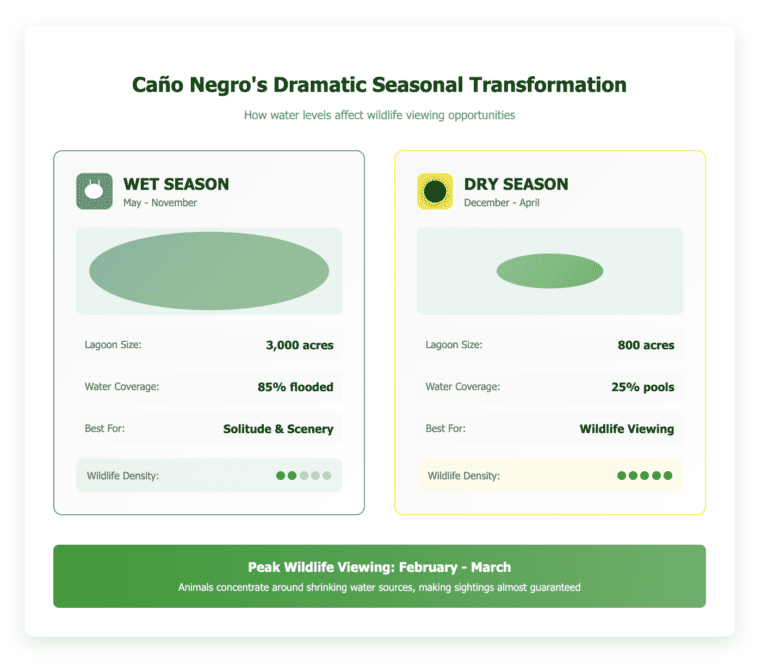
Which Animals Can You Actually See at Caño Negro?
Let’s get specific about wildlife sightings. During a typical 3-hour morning boat tour in dry season, the local guías naturalistas (naturalist guides) know exactly where to find:
Guaranteed Sightings (90% chance):
- Spectacled caimans (usually 20-30 per trip)
- Green iguanas and Jesus Christ lizards
- Great blue herons (garza azul), snowy egrets, and roseate spoonbills
- Howler monkeys (especially active 6-8 am)
Probable Sightings (60-70% chance):
- White-faced capuchin monkeys
- Three-toed sloths (check the cecropia trees)
- Nicaraguan grackles (found nowhere else in Costa Rica)
- River otters (more active in early morning)
Lucky Sightings (20-30% chance):
- Geoffroy’s spider monkeys
- Jabiru storks (Costa Rica’s largest bird)
- Tapirs (usually at dawn)
- Ocelots (extremely rare but present)
The refuge hosts Central America’s largest population of jabiru storks – if you spot one of these 5-foot-tall birds, consider yourself lucky. They’re most common from February through April. Your guide might also point out garza tigre (tiger herons) nesting in the mangroves.
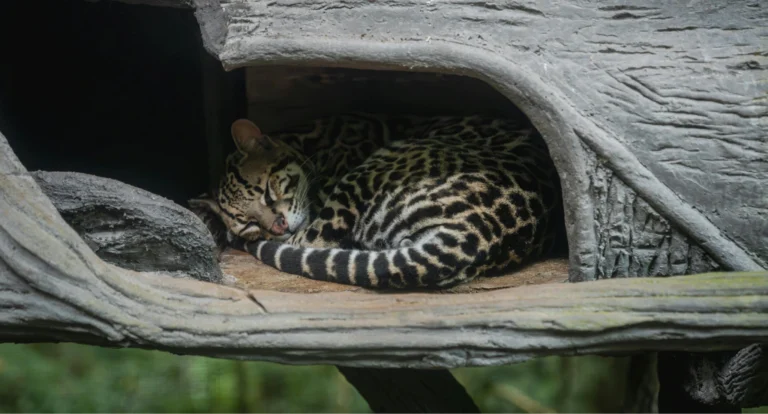
When Should You Visit Caño Negro for the Best Experience?
December to April delivers the most outstanding wildlife viewing. Here’s why: as the lagoon shrinks from 3,000 acres to about 800 acres, every animal in the refuge crowds around the remaining water. Picture 50 caimans sharing a small pool with dozens of wading birds – it’s like having a front-row seat at nature’s watering hole.
February and March hit the sweet spot. Migratory birds from North America join the year-round residents, water levels are perfect for boat navigation, and morning temperatures stay comfortable (75-80°F).
Want fewer people? Visit in early December or late April. You’ll still see plenty of wildlife, but tour groups focus on Christmas and Easter holidays.
The rainy season (May-November) offers different rewards. The flooded forest attracts different bird species, vegetation looks lusher, and you might have the entire refuge to yourself. Just know that dispersed water means wildlife spreads out too.
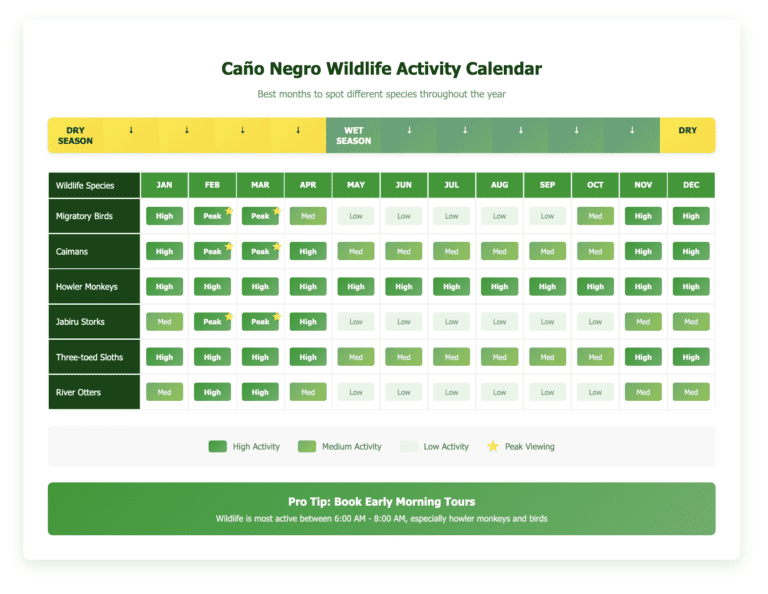
How Do You Get to Caño Negro from Major Tourist Areas?
From La Fortuna (Most Common Route)
- Distance: 70km / 43 miles
- Drive Time: 1.5 hours
- Route: Take Route 142 north through Muelle to Los Chiles
- Road Conditions: Paved entire way, though the last 20km has some potholes
From Liberia Airport
- Distance: 105km / 65 miles
- Drive Time: 2 hours
- Route: Highway 1 to Cañas, then Route 142 through Upala
- Road Conditions: Excellent highways, then good secondary roads
- Pro tip: This route passes through authentic pueblos (small towns) where you can grab fresh fruit and practice your Pura Vida greeting
From San José
- Distance: 165km / 102 miles
- Drive Time: 3 hours
- Route: Highway 1 north to San Ramón, Route 702 to Route 142
- Road Conditions: Mostly highways, well-maintained
Pick up your rental car at either airport, and the drive becomes part of the adventure. The route from La Fortuna passes through rural communities where you might spot toucans on fence posts or sloths in roadside trees. Having your own vehicle means you can stop at a local pulpería (corner store) for snacks and that perfect photo of Arenal Volcano reflected in a cattle pond.
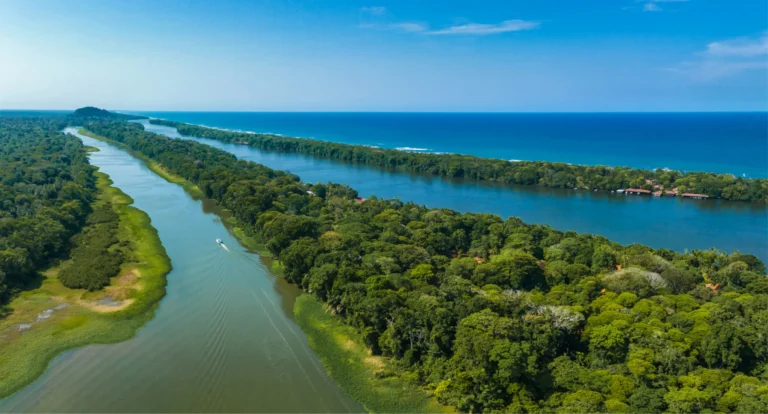
Should You Book a Tour or Visit Caño Negro Independently?
Organized Day Tours from La Fortuna
- Cost: $85-120 per person (includes transport, guide, lunch)
- Pickup: 6:00-6:30 am from La Fortuna hotels
- Duration: 8 hours total (3 hours on water)
- Pros: Zero planning required, bilingual naturalist guide included
- Cons: Less flexibility, higher cost, fixed schedule
Independent Visit with Your Rental Car
- Boat Tour Cost: $45-65 per person at Los Chiles dock
- Parking: Free at the municipal dock
- Flexibility: Choose your tour time, explore Los Chiles
- Pros: Save 40% on costs, set your own schedule
- Cons: Need to navigate yourself (though it’s straightforward)
Most visitors don’t realize you can easily drive yourself to Los Chiles and book a boat tour directly at the dock. Capitánes wait there daily, especially during high season. With a rental car, you save money and gain flexibility to explore the border town of Los Chiles, where lunch at a local soda (small family restaurant) costs $6 instead of tourist prices – try the casado at Soda El Parque.
What Should You Bring for Your Caño Negro Adventure?
Morning temperatures start around 75°F but climb to 90°F by noon, so dress in layers. Here’s your essential packing list:
Must-Have Items:
- Binoculars (boats stay 10-15 meters from wildlife for their protection)
- Sunscreen SPF 50+ (the water reflection doubles sun exposure)
- Lightweight long pants and long-sleeve shirt (sun and mosquito protection)
- Refillable water bottle (boats provide water, but bring extra)
- Camera with zoom lens (phone cameras won’t cut it for wildlife shots)
Smart Additions:
- Insect repellent with DEET (mosquitoes are worse in the rainy season)
- Rain poncho (afternoon showers can pop up year-round)
- Snacks for the drive (limited options in Los Chiles)
- Cash in colones (many boat operators don’t accept cards)
- Dry bag for electronics (boats are open and splash happens)
Pro tip: The boats have shade covers, but the sun reflects off the water from all angles. Apply sunscreen to the underside of your chin and nose – spots everyone forgets until it’s too late.
How Does Caño Negro Compare to Other Wildlife Destinations?

Caño Negro excels at delivering maximum wildlife in minimum time. While Tortuguero requires overnight stays and expensive transportation, Caño Negro works perfectly as a day trip. You’ll see more bird species here in three hours than most people spot during a week in other parks.
Where to Stay for Your Caño Negro Adventure
Since the lodges directly at Caño Negro have mixed reviews, most savvy travelers base themselves in La Fortuna (1.5 hours away) where you’ll find excellent accommodations and can easily make the morning drive for the best wildlife viewing. Here are the top-rated options:
In La Fortuna (All 4.5+ on TripAdvisor):
- Tabacón Thermal Resort & Spa (4.5/5) – Luxury option with world-class hot springs
- Nayara Gardens (5.0/5) – Adults-only luxury with private villas
- Hotel Arenal Manoa (4.5/5) – Mid-range comfort with volcano views and excellent breakfast
- Arenal Observatory Lodge (4.5/5) – Eco-lodge closest to the volcano, great for nature lovers
The advantage? After your morning wildlife cruise at Caño Negro, you’re back in La Fortuna for lunch with the afternoon free for hot springs, hanging bridges, or just relaxing by the pool with volcano views. Plus, La Fortuna’s restaurant scene beats anything near Los Chiles – try gallo pinto (rice and beans) at Soda Viquez or splurge at Don Rufino.
What’s Next After Visiting Caño Negro?
After your morning wildlife cruise, you’ve got options. The drive back to La Fortuna takes you through scenic farmland where you can stop at Iguana Farm or grab fresh fruit from roadside stands. Time it right and you’ll reach La Fortuna for lunch with the afternoon free for hot springs.
Heading to the Caribbean? Take Route 4 from Los Chiles – it connects to the highway near San Carlos, shaving an hour off the drive to Tortuguero or Puerto Viejo.
Planning to explore more of northern Costa Rica? Your rental car opens up lesser-known spots like Tenorio Volcano National Park (1 hour from Los Chiles) where you can hike to the celestial blue Río Celeste waterfall.
Having reliable transportation makes Caño Negro accessible without the markup of organized tours. Pick up a 4×4 at Liberia Airport if you’re exploring the north, or grab any vehicle at San José Airport if you’re combining Caño Negro with Central Valley destinations. The GPS units include Los Chiles pre-programmed, and the route is straightforward enough that you won’t need to worry about getting lost.
The beauty of Caño Negro lies in its authenticity – this isn’t a manufactured tourist experience but rather a glimpse into Costa Rica’s wild wetland ecosystems. With your own transportation, you control the pace, choose your timing, and save enough money to add another adventure to your itinerary. The wildlife won’t wait, but with proper planning, you won’t miss them either.
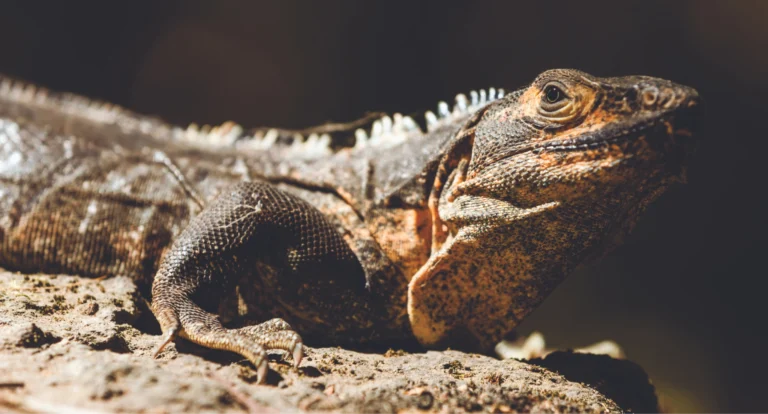
Frequently Asked Questions
What is the best time to visit Caño Negro?
February and March are your golden tickets – that’s when migratory birds join the locals, and water levels are just right for boat navigation. The dry season (December-April) concentrates wildlife around shrinking water sources, so you’ll spot 50+ caimans sharing pools with hundreds of birds. Want fewer crowds? Hit early December or late April. Rainy season (May-November) means lusher scenery and having the refuge to yourself, but wildlife spreads out across the flooded forest.
How do I get to Caño Negro?
From La Fortuna, it’s a straight shot north – 70km on Route 142 through Muelle to Los Chiles (1.5 hours). The road is paved the entire way, though the last 20km has some character (read: potholes). Once in Los Chiles, park free at the municipal dock and grab a boat tour for $45-65. With your rental car, you’ll save 40% compared to organized tours from La Fortuna. GPS coordinates for the dock: 11.0306° N, 84.7156° W. Pro tip: Stop at the fruit stands along the way – best mangoes you’ll ever taste.
What should I wear to Caño Negro?
Think “stylish swamp chic” – lightweight long pants and a long-sleeve shirt in breathable fabric. Sounds counterintuitive in 90°F heat, but trust me, you’ll thank yourself when you’re not slathered in sunscreen every hour or feeding the mosquitoes. Bring layers though – mornings start at a comfortable 75°F. Don’t forget a wide-brimmed hat and shoes that can get wet (boat floors aren’t always dry). Skip the camo unless you want other tourists thinking you’re trying too hard.
Is Caño Negro worth it if I’m already going to Tortuguero?
These are completely different experiences. Caño Negro is a wetland with the highest concentration of wading birds in Costa Rica – we’re talking 300+ species, including the massive jabiru stork. Tortuguero is all about sea turtles and canal systems. Plus, Caño Negro takes half a day and costs half the price. You can drive yourself there in 90 minutes from La Fortuna, while Tortuguero requires boats or planes and overnight stays. Different ecosystems, different wildlife, different vibes.
Do I need a 4×4 to reach Caño Negro?
Not required, but helpful during the rainy season. The main route from La Fortuna is paved, and any sedan handles it fine in the dry season. A 4×4 gives you confidence on the potholed sections and opens up scenic backroad options through Upala. If you’re combining Caño Negro with Tenorio Volcano or other northern adventures, spring for the 4×4. Otherwise, save your money for that extra boat tour at dawn when tapirs are active.
How much does Caño Negro cost to visit?
Budget $45-65 per person for the boat tour if you drive yourself to Los Chiles. Tours from La Fortuna run $85-120 but include transport and lunch. The refuge entrance fee is included in your boat tour price. Parking’s free at the dock, lunch in Los Chiles costs about $6 (try the casado at Soda El Parque), and you’ll want cash in colones since many boat operators don’t take cards. All in, you’re looking at $60-80 per person for the DIY version, half that of similar wildlife experiences elsewhere.
Can you see jaguars at Caño Negro?
Technically, yes, but don’t plan your trip around it. Jaguars live in the refuge, but sightings are lottery-ticket rare – maybe 2-3 reported per year, usually by researchers at dawn. You’ve got better odds of seeing one at Corcovado National Park. What you WILL see at Caño Negro: three types of monkeys, sloths, 30+ caimans per trip, river otters, and enough birds to fill ten memory cards. Come for the guaranteed wildlife spectacular, consider any big cat sighting a miracle bonus.
What’s the difference between Caño Negro and Palo Verde?
Think quantity versus accessibility. Caño Negro has more bird species (300+ vs 300+) and better overall wildlife density, especially during the dry season when animals concentrate around water. Palo Verde offers hiking trails and hilltop views that Caño Negro doesn’t have – it’s all boat tours here. Caño Negro is easier to reach from La Fortuna (1.5 hours vs 2.5 hours), while Palo Verde works better from Guanacaste beaches. Both are fantastic for birds, but Caño Negro edges ahead for sheer variety and those Instagram-worthy caiman congregations.
